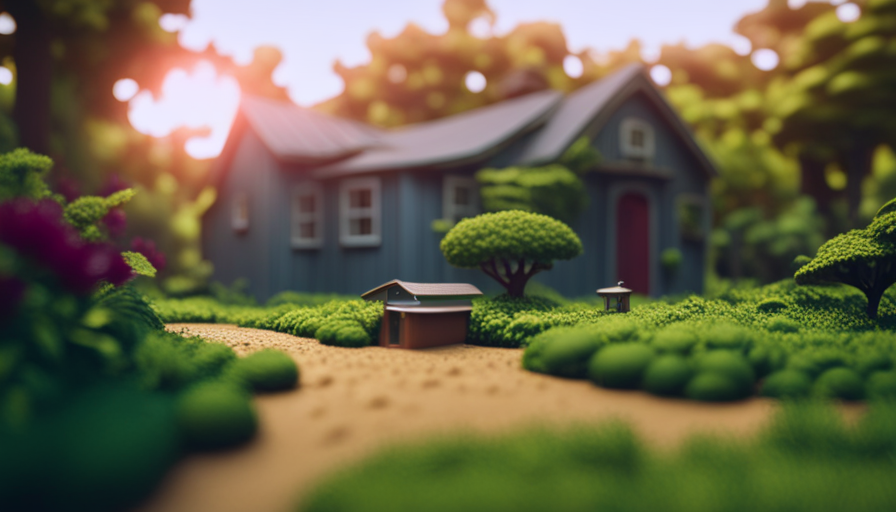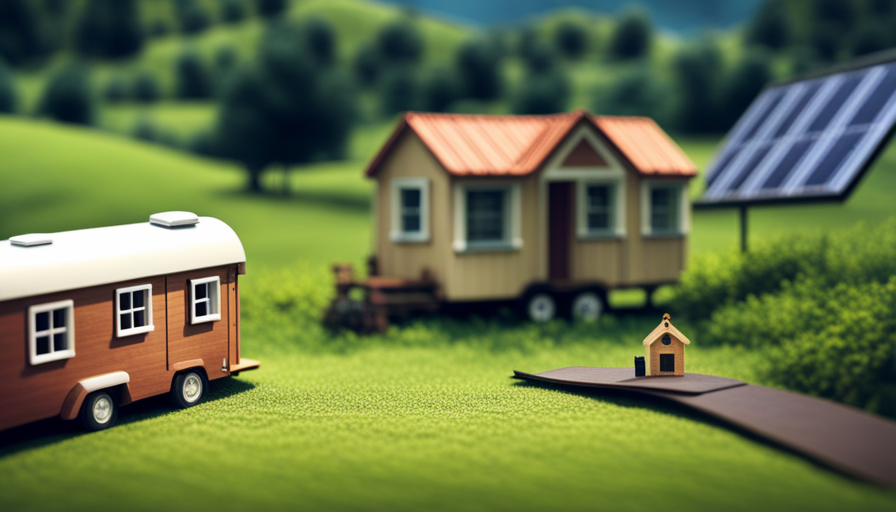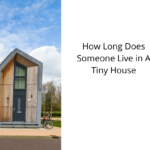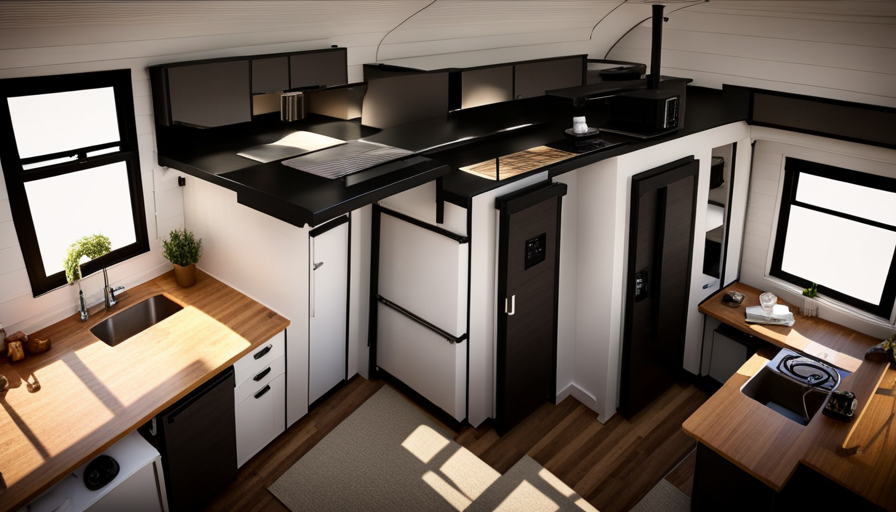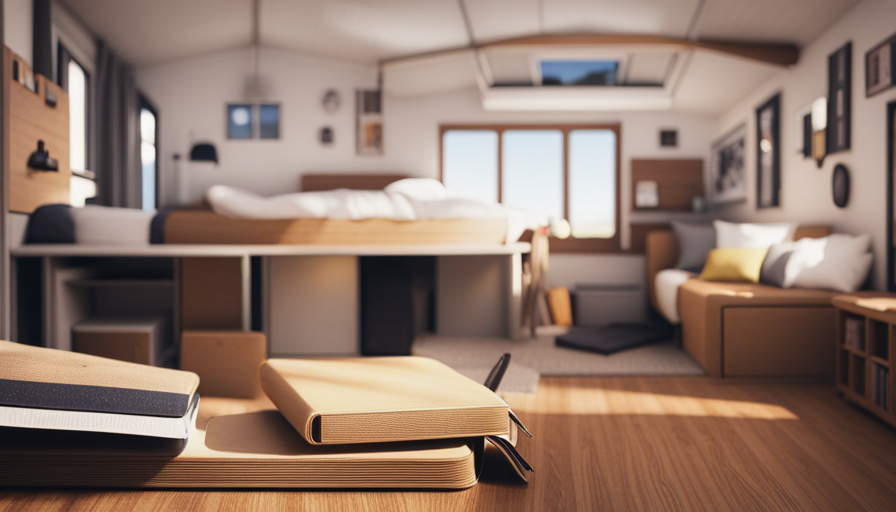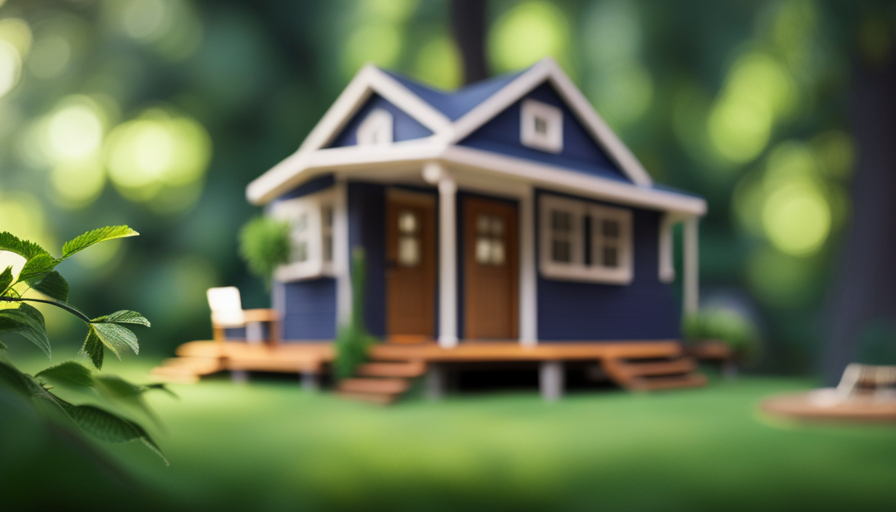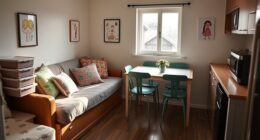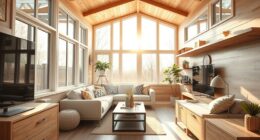Are you aware that the interest in small living spaces, often referred to as the tiny house movement, has seen a consistent rise in popularity throughout the last ten years? Indeed, a recent study has found that more than 63% of people in the United States express an interest in inhabiting a tiny house.
If you’re one of those individuals considering the purchase of a tiny house, you’ve come to the right place. In this article, I will provide you with a comprehensive guide on how to buy a tiny house. From determining your budget and financing options to finding a reputable builder or DIY resources, I will walk you through the entire process.
We’ll also discuss important factors such as location, legal considerations, and space requirements. Additionally, I’ll provide tips on off-grid living and connecting to utilities, as well as storage and organization solutions.
Lastly, we’ll delve into the logistics of moving and settling into your new tiny house. So, let’s dive in and explore the world of tiny house living together.
Key Takeaways
- Determine budget and explore financing options such as personal loans, RV loans, or home equity loans.
- Research different types and styles of tiny houses, considering factors like size, design, mobility, and layout.
- Find a reputable tiny house builder or utilize DIY resources like the Tiny House Builder Directory or online DIY plans.
- Consider location and legal considerations, such as zoning laws, building codes, and permits required for tiny house placement.
Determine Your Budget and Financing Options
Figuring out your budget and exploring different financing options is crucial when it comes to buying a tiny house. Determining affordability is the first step in this process. You need to assess your current financial situation and determine how much you can comfortably spend on a tiny house. Consider your income, expenses, and savings to get a clear understanding of what you can afford.
Once you have a budget in mind, it’s time to explore loan options. There are several ways to finance a tiny house, including personal loans, RV loans, and home equity loans. Personal loans are unsecured and can be used for any purpose, while RV loans are specifically designed for mobile homes. Home equity loans use the equity in your current home to secure a loan for your tiny house. Research different lenders and compare interest rates, terms, and repayment options to find the best loan for your needs.
Transitioning into the next section, it’s important to research different types and styles of tiny houses. By understanding the various options available, you can narrow down your choices and find the perfect tiny house that fits your budget and lifestyle.
Research Different Types and Styles of Tiny Houses
Exploring various types and styles of compact dwellings can provide you with valuable insights into the world of minimalist living. When researching different types and styles of tiny houses, it’s important to consider your personal preferences and needs.
Here are four key considerations to keep in mind:
-
Size: Tiny houses come in various sizes, ranging from as small as 80 square feet to around 400 square feet. Think about how much space you require and what amenities are essential for your lifestyle.
-
Design: There’s a wide range of designs available, from traditional-looking cottages to modern, sleek structures. Consider the architectural style that appeals to you and matches your aesthetic taste.
-
Mobility: Some tiny houses are built on wheels, allowing for easy mobility and flexibility. Others are designed to be permanent structures. Determine whether you want a mobile tiny house or a stationary one.
-
Layout: Tiny houses require smart and efficient layouts to optimize space. Look for designs that maximize functionality and storage options, such as loft beds, hidden storage compartments, and multipurpose furniture.
Living in a tiny house has its pros and cons. On the positive side, it promotes a simpler lifestyle, reduces environmental impact, and offers financial freedom. However, it can also be challenging to adjust to the limited space and lack of privacy.
Transitioning into finding a reputable tiny house builder or DIY resources, it’s crucial to consider your budget and financing options.
Find a Reputable Tiny House Builder or DIY Resources
Discovering a trustworthy builder or reliable DIY resources can lead you on an exciting journey towards creating your dream compact dwelling. When it comes to finding a reputable tiny house builder, it’s important to do thorough research and seek recommendations from others who have already built their own tiny homes. One helpful resource is the Tiny House Builder Directory, which provides a comprehensive list of builders across the country, along with reviews and ratings from previous customers. This directory allows you to compare different builders and find the one that best fits your needs and budget.
If you’re more inclined to take the do-it-yourself route, there are plenty of DIY tiny house plans available online. These plans provide detailed instructions and blueprints, allowing you to build your own tiny house from scratch. Websites like Tiny House Design and The Tiny Life offer a wide selection of plans to choose from, ranging from simple and minimalist designs to more intricate and customized options.
By exploring these resources, you can gain valuable insights into the building process and make informed decisions about your tiny house project. Once you have a trustworthy builder or DIY plan in mind, it’s time to consider the location and legal considerations for your tiny house. Transitioning into the next section, it’s important to carefully evaluate zoning regulations and any permits that may be required for your chosen location.
Consider Location and Legal Considerations
When it comes to finding the perfect spot for your compact dream home, you’ll need to consider the location and legal aspects to ensure a smooth transition into your new lifestyle.
Choosing the right location is crucial for your tiny house. Start by evaluating your needs and preferences. Do you want to be close to nature or in a bustling city? Consider factors such as climate, proximity to amenities, and access to resources.
Additionally, understanding legal regulations is vital to avoid any complications. Research zoning laws and building codes in your desired area to ensure that you can legally park or build your tiny house. Some areas may have restrictions on the size of the house or where it can be located. It’s also important to check if you need any permits or licenses.
By carefully considering these location and legal aspects, you can ensure a smooth transition into your tiny house lifestyle. Assessing your needs and space requirements will be the next step in creating your ideal compact living space.
Assess Your Needs and Space Requirements
Determining the perfect size and layout for your compact dream home requires a deep understanding of your personal desires and space requirements. When it comes to living in a tiny house, space optimization and minimalist living are key.
Here are three important factors to consider when assessing your needs and space requirements:
-
Functionality: Think about how you plan to use your tiny house. Will it be a full-time residence or a vacation home? Consider the number of bedrooms, bathrooms, and any special features you may need, such as a home office or a kitchen with ample storage.
-
Storage Solutions: In a small space, maximizing storage is crucial. Look for creative storage solutions like built-in cabinets, folding furniture, or multi-purpose pieces. Consider utilizing vertical space with loft areas or shelving units.
-
Flexibility: As your needs evolve over time, it’s important to have a flexible living space. Look for customizable layouts that can adapt to different purposes or allow for future expansions. Flexibility also includes considering outdoor spaces like decks or patios to extend your living area.
Assessing your needs and space requirements is the first step towards designing and customizing your tiny house to perfectly fit your lifestyle.
Design and Customize Your Tiny House
Now that you have assessed your needs and space requirements for a tiny house, it is time to move on to the exciting stage of designing and customizing your dream home. This is where you can really let your creativity shine and make your tiny house a reflection of your personal style and preferences.
When it comes to designing a tiny house, there are a few key tips to keep in mind. First, prioritize functionality and make the most of every inch of space. Think about clever storage solutions, such as built-in cabinets and multipurpose furniture. Consider using vertical space by incorporating loft areas or high shelves.
Another important aspect to consider is the layout of your tiny house. Think about how you will use each area and ensure that there is a good flow between spaces. Keep in mind that open floor plans can create a sense of spaciousness in a small area.
To help spark your creativity, here is a table showcasing some design ideas and space-saving solutions:
| Design Tips | Space-Saving Solutions |
|---|---|
| Use light colors | Build in storage |
| Utilize natural light | Foldable furniture |
| Opt for multipurpose | Loft areas |
| furniture | High shelves |
| Incorporate outdoor | Hidden storage |
| living space | solutions |
With these design tips and space-saving solutions in mind, you are well on your way to creating the perfect tiny house. In the next section, we will discuss how to plan for off-grid living or connection to utilities, ensuring that your tiny house is set up for a comfortable and sustainable lifestyle.
Plan for Off-Grid Living or Connection to Utilities
To ensure your tiny house is equipped for off-grid living or connection to utilities, you’ll want to consider your energy needs and options, just like a camper deciding whether to rely on solar power or plug into a campground’s electrical hookup.
Off-grid living means being self-sufficient and not relying on public utilities such as electricity, water, or sewage. This lifestyle offers the freedom to live anywhere without being tied to traditional infrastructure. However, it also requires careful planning and investment in alternative energy sources, such as solar panels, wind turbines, or propane generators.
On the other hand, living connected to utilities provides convenience and reliability. You can enjoy the comforts of a regular home with access to reliable electricity, water, and sewage systems. It eliminates the need for additional investments in alternative energy sources and reduces maintenance responsibilities. However, you will be tied to the availability and reliability of public utilities.
When considering off-grid vs. connected living, weigh the pros and cons based on your preferences, location, and budget.
Transitioning into the subsequent section about storage and organization solutions, it’s important to consider how to optimize space in your tiny house.
Consider Storage and Organization Solutions
When it comes to optimizing space in your tiny home, it’s crucial to consider storage and organization solutions. In such a small living space, every inch counts, and having effective storage solutions can make a world of difference.
Here are some storage and organizing tips to help you make the most of your tiny house:
-
Utilize vertical space: Install shelves, hooks, and hanging organizers on walls to maximize storage. Vertical storage solutions can help keep your belongings organized and easily accessible.
-
Invest in multi-purpose furniture: Look for furniture pieces that serve multiple functions, such as a bed with built-in storage underneath or a coffee table with hidden compartments. These versatile pieces can help you save space while providing ample storage options.
-
Use storage containers and bins: Clear plastic bins and storage containers can be a lifesaver in a tiny home. They allow you to neatly organize your belongings and keep them easily accessible. Label the containers to quickly find what you need.
By implementing these storage solutions and organizing tips, you can make the most of your tiny house and create a clutter-free living space. With your belongings neatly organized, you’ll be better prepared for the logistics of moving and settling into your tiny house.
Prepare for the Logistics of Moving and Settling into Your Tiny House
Get ready to embark on the exciting journey of moving into your cozy dream home, and remember, "Out with the old, in with the new" as you prepare for the logistics of settling into your tiny haven. Moving into a tiny house requires careful planning and organization to ensure a smooth transition. Here are some key considerations to help you navigate the moving logistics and settling process.
First, it’s important to think about the size and weight of your belongings. Since space is limited in a tiny house, you’ll need to prioritize what items are essential and let go of the rest. Consider donating or selling items that won’t fit or aren’t necessary in your new space.
Next, create a detailed plan for moving day. Map out the route to your new location and ensure that the tiny house can be safely transported. If you’re hiring a professional moving company, communicate the dimensions and weight of your tiny house to ensure they have the necessary equipment and expertise.
Once you’ve arrived at your new location, take the time to settle in and make your tiny house feel like home. Organize your belongings in a way that maximizes space and functionality. Consider using storage solutions such as built-in cabinets, wall-mounted shelves, and multi-purpose furniture.
To emphasize the importance of organization and maximize space, here’s a table showcasing some storage ideas:
| Storage Idea | Description |
|---|---|
| Loft Storage | Utilize the vertical space by creating storage in the loft area. |
| Under Stair Storage | Install drawers or shelves under the stairs for additional space. |
| Wall-Mounted Hooks | Hang items like coats and bags on hooks to free up floor space. |
| Foldable Furniture | Opt for foldable tables and chairs that can be stored when not in use. |
As you settle into your tiny house, embrace the tiny house lifestyle and enjoy the benefits of simplified living. With thoughtful planning and organization, your tiny haven will become a cozy and functional space that brings you joy and fulfillment.
Embrace the Tiny House Lifestyle and Enjoy the Benefits
Immerse yourself in the tiny house lifestyle and savor the countless rewards that come with embracing a simpler, more intentional way of living. When you downsize to a tiny house, you open up a world of benefits that go far beyond just having a smaller space.
Here are a few ways that simplifying your life by living in a tiny house can have a positive impact:
-
Financial freedom: By choosing to live in a tiny house, you can drastically reduce your monthly expenses. With a smaller mortgage or no mortgage at all, you can save money for other important things in life, such as travel or pursuing your passions.
-
Environmental sustainability: Tiny houses have a smaller carbon footprint compared to traditional homes. With less square footage to heat, cool, and maintain, you can significantly reduce your energy consumption and live a more eco-friendly lifestyle.
-
More time and freedom: With fewer possessions and less space to clean and maintain, you’ll find yourself with more time and freedom to focus on the things that truly matter to you. Whether it’s spending quality time with loved ones, pursuing hobbies, or simply enjoying the outdoors, a tiny house can provide the space and flexibility to do so.
So, if you’re ready to simplify your life and reap the benefits of downsizing, consider embracing the tiny house lifestyle. It’s a decision that can lead to financial freedom, environmental sustainability, and a newfound sense of freedom and fulfillment.
Frequently Asked Questions
How much does a tiny house typically cost?
Typically, the cost of a tiny house varies depending on factors such as size, materials, and location. However, a cost comparison can help determine the most affordable option. Financing options like loans and grants are also available.
Can I get a mortgage to finance a tiny house?
Yes, you can finance a tiny house with a mortgage. There are various financing options available for tiny houses, allowing you to make your dream of owning a tiny house a reality.
Are there any legal restrictions on living in a tiny house?
Zoning regulations and building codes vary by location and may restrict living in a tiny house. It is important to research and comply with these regulations to ensure that you can legally live in a tiny house.
How long does it take to build a tiny house?
It typically takes around 3 to 6 months to build a tiny house, depending on the complexity and size. The construction process involves planning, acquiring materials, and executing the build with attention to detail and craftsmanship.
What are some common challenges of living in a tiny house?
Living in a tiny house poses challenges such as limited space management. Downsizing has pros and cons, with benefits like lower costs and reduced environmental impact, but it requires careful organization and minimalism.
Conclusion
In conclusion, embarking on the journey to buy a tiny house can be an exciting and rewarding experience. By determining your budget and researching different types and styles, you can make an informed decision. Finding a reputable builder and considering location and legal considerations are also important factors to consider. Assessing your needs, planning for off-grid living, and considering storage solutions will help you create a space that meets all your requirements. Finally, embracing the tiny house lifestyle will allow you to enjoy the benefits of minimalism, sustainability, and financial freedom.
So, step into the world of tiny houses and start living large in a small space!
Hi, I’m Emma. I’m the Editor in Chief of Tiny House 43, a blog all about tiny houses. While tree houses are often associated with childhood, they can be the perfect adult retreat. They offer a cozy space to relax and unwind, surrounded by nature. And since they’re typically built on stilts or raised platforms, they offer stunning views that traditional homes simply can’t match. If you’re looking for a unique and romantic getaway, a tree house tiny house might just be the perfect option.
